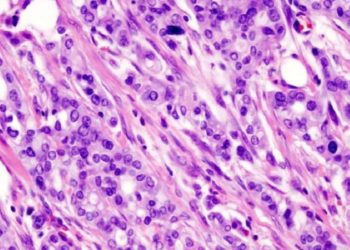CA19-9 kinetics may predict pancreatic cancer resectability
1. Both an absolute increase of pre-operative CA 19-9 levels exceeding 50 U/ml as well as rate of change greater than 1 U/ml/day were strongly associated with higher rates of unresectable disease.
2. Twenty-three percent of patients with resectable disease had a rate of change of CA 19-9 greater than 1 U/ml in the resectable group, with 77% in the group with unresectable disease.
Evidence Rating Level: 2 (Good)
Study Rundown: It is estimated that between 10% and 25% of patients who undergo surgical tumor resection for pancreatic adenocarcinoma are ultimately deemed to have unresectable disease, leaving patients unnecessarily subjected to the risks and complications associated with the surgical procedure as well as delaying the delivery of any palliative systemic therapy. Recent research has sought to identify pre-operative markers which could be predictive of unresectable disease. One such marker, sialylated Lewis carbohydrate antigen 19-9 (CA19-9), has been shown to be associated with more malignant disease in pancreatic adenocarcinoma. However, widespread utility of levels of CA19-9 for the advisement of surgical decision-making has been limited due to the lack of consensus with regards to a specific cutoff and the cases of biliary obstruction comorbid with disease, which elevates blood levels of the marker. This study consequently examined kinetics of CA19-9 and found that both absolute increases of levels greater than 50 U/ml as well as a rate of change greater than 1 U/ml/day were strongly associated with higher rates of unresectable disease. There was no association found between the kinetics of CA19-9 and survival in resectable disease. This study aids in potentially identifying a pre-operative means to recognize unresectable pancreatic adenocarcinoma. However, the study is limited by its retrospective nature, small sample size, and cases which spanned 16 years, not accounting for potential changes in surgical indications and technique. Inconsistency in pre-operative CA19-9 measurement timing may also have introduced error into both the measured absolute change and rate of change in CA19-9 levels.
Click to read the study in Annals of Surgical Oncology
Relevant Reading: Utility of Tumor Markers in Determining Resectability of Pancreatic Cancer
In-Depth [retrospective]: A total of 72 patients who underwent exploratory surgery via laparotomy or diagnostic laparoscopy for potentially resectable pancreatic adenocarcinoma were included in the analysis. All patients underwent surgery at the University of California, Davis Medical Center between 1996 and 2012. Patients were selected on the basis of having, at a minimum, 2 preoperative levels of CA19-9 in their records. A suitable threshold of the absolute change in CA pre-operatively was determined to be ≥50 U/mL and the rate of change was ≥1 U/ml/day by receiver operating characteristic (ROC) curve analysis. Of patients with resectable disease, only 26% had changes in levels of CA19-9 exceeding 50 U/ml, compared to 60% in the unresectable group (p = 0.004). A rate of change in pre-operative CA19-9 levels ≥1 U/ml/day was also a strong predictor an unresectable tumor, with 23% of patients in the resectable group having a rate of change in CA19-9 exceeding 1 U/ml/day, compared to 77% in the group with unresectable disease (p=0.001). By Kaplan-Meir survival analysis, both the change in CA 19-9 < 50 U/ml and rate of change < 1 U/ml were shown to be predictive of increased survival (p = 0.039 and p = 0.019, respectively). However, neither variable was predictive of survivorship when isolating analysis to those with resectable disease only.
More from this author: Robotic adnexal surgeries may have more complications than laparoscopic, Subtype of metastatic esophageal cancer not a contraindication to surgery, Coronary angioplasty safe and effective at facilities without on-site cardiothoracic surgery
Image: PD
©2012-2014 2minutemedicine.com. All rights reserved. No works may be reproduced without expressed written consent from 2minutemedicine.com. Disclaimer: We present factual information directly from peer reviewed medical journals. No post should be construed as medical advice and is not intended as such by the authors, editors, staff or by 2minutemedicine.com. PLEASE SEE A HEALTHCARE PROVIDER IN YOUR AREA IF YOU SEEK MEDICAL ADVICE OF ANY SORT.







